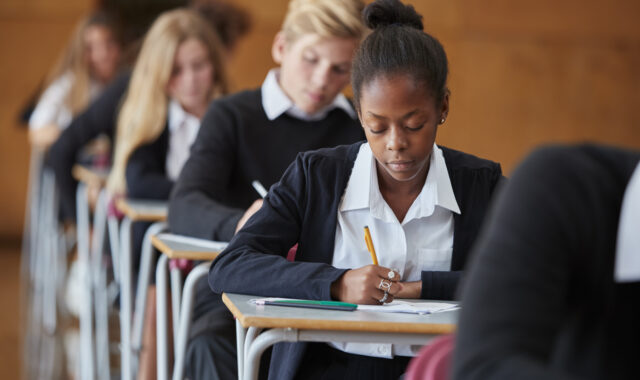Contents:
A blank page can be a fearful thing. As I sit typing this (cocooned in the corner of a bustling coffee shop), it seems a fearful thing to me, too. One by one, words tentatively appear, and yet the whiteness of the page dominates and suffocates the lettered blackness.
It can be an especially fearful thing for our students. Surrounded by the silence of an examination hall, pens scratching cold paper, they sit and stare at the mountainous alps of their booklet. The summit stretches out a great distance away, with so little time to plot and navigate their way.
This is often most keenly felt in creative writing. Being creative on demand is no easy task. The blankness of the paper is only compounded by the apparent blankness of ideas. And still, the clock ticks. In this article, I’ll share four top tips for helping students get better at creative writing, ensuring they always have something ready to fill the whiteness of the page.
Tip 1: Crossing out
One of the biggest conceptual shifts I’ve made in my teaching of creative writing is to focus on crossing out. When we—or our students— cross something out in their writing, what does it imply? It invariably implies a moment of thought and consideration. Is this the best word the gesture suggests, or should I use a different one?
Encouraging students to adopt a crossing-out mentality can be hugely powerful. As we write, I’ll often remind students to look for any words they could cross out, modelling this in my own writing. As I write, I cross out, always being sure to narrate why I’ve crossed something out and what is replacing it.
Of course, in and of itself, crossing out does not guarantee progress. It is a proxy, but a helpful one. Crossing out becomes a concrete and easily understood analogy for the kind of deliberate, sustained crafting that so often characterises the best writing. We don’t just want students to fill up their blank pages; we want them to fill them up with excellent writing.

Tip 2: Explicitly teach sentence stems
In order to cross out, students need something to cross out in the first place. This is where repeatable and recyclable sentence stems come into their own. They provide students with snippets of excellent writing they can drag and drop into their response, adapting as necessary.
Students often complain—rightly so—that creative writing can be bereft of content to revise. Sentence stems give them something tangible to rehearse. Teach them in advance, show students how to manipulate them, and get students to experiment on their own.
Tip 3: Build a planning routine
If the sentence occupies the micro, then students also need a sharp and cohesive macro structure in order to succeed. This is where planning becomes essential.
To help students with this, I explicitly teach and model a particular planning routine that can be adapted and adopted at the start of an examination. This helps students make sure they’re asking the best questions as well as get them into the zone.
This routine always looks the same, sketched out on a single side of A4, and goes like this:
- POV: Students decide the narrative point of view they wish to adopt, which is especially valuable if responding to an image, like many questions require.
- Happy or sad: Students now consider if their point of view is happy or sad. I purposely keep this question very broad, but they may wish to be a little more nuanced in their emotional choice. The key is that they’re thinking about an emotional groove for their piece.
- Why? Now, students can reflect on why their point of view is happy or sad, beginning to build some kind of backstory or narrative thrust to their writing.

At this point, and with some basics covered, students can sketch out an overall structure for their response. At the most basic level possible, I like: First, Next, Next, And Then. What happens first, and then next, and then next, and then how does it end?
Finally, I ask students to consider a big idea they would like to convey within their writing.
With all of this mapped out, students can now begin to write.
Tip 4: Go big or go home
Let’s pause for a moment on this idea of a ‘big idea’. It is easy to imagine what this means when teaching a literature text, and we probably spend a lot of time considering it with our classes.
What is Shakespeare trying to accomplish in Macbeth, we might explore? Interwoven with our discussion of the play, we consider Shakespeare’s depiction of power and the way it corrupts, as well as his depiction of kingship or femininity. These are some of the play’s big ideas.
A consideration of the ‘big’ is just as important for a student’s own writing as it is for the literature they study. What is it that they wish to show or explore in their writing? What do they want to do? Helping students to appreciate they can have something to say within their own writing can be truly empowering and liberating.
In my own modelling, I like to return to the concept of time. This unlocks so many interesting directions: transience, time passing, memory, recapturing youth. But it also provides a wealth of imagery for students to leverage. Wrinkled hands, a faded wedding ring, a scratched and crumpled photograph, an item of clothing lovingly stored away at the back of a wardrobe, gathering dust.
This block is currently empty. Please add some content.
The end
A blank page can be a fearful thing, it’s true. But one filled with scribbled writing, well, that can be joyful.
These four strategies will hopefully help your students make sure they turn their blank pages into a piece of writing they can be truly proud of.







Comments